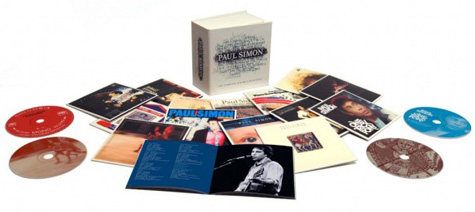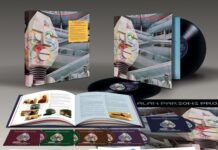There can be little argument as to the importance and impact of Paul Simon as a songwriter and singer. As if he didn’t achieve enough with Simon and Garfunkel, his solo work found him transcending the boundaries of pop, breaking cultural barriers and exploring variations of World music before it became fashionable. Legacy has packaged 15 albums (12 studio albums and two live sets) that span Simon’s most magical moments — from his 1972 self-titled debut right up to his most recent studio release, 2011’s So Beautiful Or So What. Released in conjunction with the singer’s 72nd birthday, The Complete Albums Collection is the whole story as you know it, with a few twists and turns you may not know.
To make sure they have the whole “complete” angle covered, 1965’s The Paul Simon Songbook, the singer’s first official solo album recorded in London, is here and it includes many songs that were eventually recorded by Simon and Garfunkel, namely “I Am A Rock,” “The Sound Of Silence” and the Dylanesque “A Simple Desultory Philippic (Or How I Was Robert McNamara’d Into Submission).” Alternate versions of “I Am A Rock” and “A Church Is Burning” will satisfy collectors, although a previous 2004 reissue of this album included these then, so who knows.
It was upon the release of 1972’s self-titled release (Paul Simon) that the first phase of Paul Simon’s solo career began. This is where he firmly marked his territory and suspended any doubts about whether he was capable of recording his own songs without Art Garfunkel to sweeten the harmonies. That’s because the music went deeper, pulling in a flood of instrumentation and applying the right touches of craftsmanship. With a clutch of top-notch players as his disposal, it was a no-brainer for Simon on how to proceed.
The reggae-flavored “Mother And Child Reunion” was the first of many groundbreaking recordings Simon would make outside his comfort zone, in this case in Jamaica with Jimmy Cliff’s backing band. Then it was on to Paris for “Duncan,” an alluring melody, lead by Simon on acoustic and vocal, and catapulted into another world by Los Incas on percussion, flutes and charango. Where it goes from there really depends on your mood “Everything Put Together Falls Apart, “Run That Body Down” and “Armistice Day” all stay low-key, while “Me And Julio Down By The Schoolyard” kicks up the beat with a little more of that reggae feel. In the end, Paul Simon is the perfect start for a career strewn with peaks and valleys.
There Goes Rhymin’ Simon, the 1973 follow up mostly recorded at Muscle Shoals, sustains a balance of crafty hits and folkier fare. “Kodachrome” is undoubtedly one of Simon’s snappier hits, a carry-on nugget any songwriter would have loved to have written. From there, a myriad of flavors are taste-tested and paraded out. “Tenderness” is a vocal-laden snoozer featuring the Dixie Hummingbirds with a horn arrangement by Allen Toussaint, whereas “Take Me To The Mardi Gras” could have easily been a hit for Simon and Garfunkel. “One Man’s Ceiling Is Another Man’s Floor” is Simon living out a New Orleans jazz sequence without recourse. From there a relative calm right up through “Loves Me Like a Rock.” Four extra demos fill out the rest of remastered box set edition.
Paul Simon in Concert: Live Rhymin’ is the first of the set’s two live releases. While it is the official document of Simon’s first solo tour, it’s obviously filling in for a year without a studio album and showcasing not only the best from Paul Simon and There Goes Rhymin’ Simon, but the singer’s interpretations of classic Simon & Garfunkel material. Frankly, some listeners may struggle with the Jessy Dixon Singers and their vocal enhancements to “The Sound s of Silence ” and “Bridge Over Troubled Water,” but it was these kind of bold musical ideas and Simon’s own expanding tastes that would define his career. Sill, just before launching into an alluring, lone version of “America,” Simon showed his 60s idealistic colors when he responded to an audience’s member’s request for a few words with the simple quip of – “Well, let’s hope that we continue to live…”
Simon’s third and final album of the 70s, Still Crazy After All These Years, finds the singer settling into middle-of-the-road mode, possibly due to his recent divorce, as the title track clearly expresses. The title track was representative on the kind of sleepy, laid back music that filled most of the record. Not only had the music mellowed, but apparently any misgivings with Garfunkel were set aside for the first of many reunions on “My Little Town.” Once again, Simon was able to pull in the best players available, including bassist Tony Levin, guitarist Hugh McCracken, singers Phoebe Snow and Patti Austin. Steve Gadd’s drumming on “50 Ways To Leave Your Lover” remains a textbook lesson in syncopation, while keyboardist Bob James, guitarist Joe Beck and saxophonist Phil Woods all helped usher in strains of jazz into Simon’s already eclectic songbook.
Simon wouldn’t issue another solo album until 1980 with One Trick Pony, which doubled as sort of a soundtrack for a film of the same name that he wrote and starred in. While both the film and album met with marginal critical and popular, it still featured a high caliber of musicianship and spawned the hit, “Late In The Evening,” which featured the type of New World and African rhythms that would be more widely explored on subsequent releases. Four unreleased songs from the film and sessions fill out the box set’s version of One Trick Pony.
A 1981 reunion with Garfunkel put Simon’s solo career on hold, but he returned in 1983’s underwhelming Hearts & Bones. While the album does have its moments – the title track is a blissful, hopeful swing, and both “Rene And George Magritte With Their Dog After The War” and “The Late Great Johnny Ace” resonate with Simon’s innate skills of storytelling – but it fell short with the public and the critics, alike. At a time when superficial enhancements and attention to the visuals dominated the music world, it would have been easy to write off Paul Simon as a relic of the 60s and 70s striving to stay relevant past his expiration date. But then Graceland came along and changed everything.
The subject of numerous reissues and reconfigured packaging, Graceland is nonetheless mandatory to this collection, rounded out three bonus tracks, alternate versions of “Homeless,” “Diamonds On The Soles Of Her Shoes” and “All Around The World Or The Myth Of Fingerprints.” The origins of Graceland go back to when Simon heard a tape of South African music and was moved to seek out the musicians. He ended up traveling to South Africa to capture the easy flow and joy expressed in a sound he grew to love.
“Boy In The Bubble” came from a simple line on the accordion courtesy of one mild-mannered Forere Motloheloa. The main riff behind “You Can Call Me Al” was inspired by a lick played by guitarist Ray Phiri. “All Around The World or the Myth of Fingerprints” sprung from a jam between Simon and Los Lobos. The title track, Simon’s personal favorite and another song shaped by Phiri’s unique turnaround, would win a Grammy for Song of the Year a year after Graceland took top honors for Album of the Year.
After Graceland, Simon went even deeper on 1990’s The Rhythm Of The Saints. The album includes the same sensibility as Graceland, and many of the same South African musicians as well; however, an extra emphasis was put on the percussion, much of which was recorded in Brazil with Mingo Araújo and other Brazilian percussionists. There’s no denying tracks like “The Obvious Child” and “Proof” relish in their cultural flavors, but it’s tricky to say if the album is as euphoric as it s predecessor, given its own success and acclaim. Undoubtedly as good a follow-up as could be expected when you consider how monumental Graceland was.
Paul Simon’s Concert In The Park from 1991 is the other live release, comprising two CDs in the box set. This historic show, the singer’s first nearly 10 years after his reunion with Garfunkel, was filed as well as recorded. At this point in his career, Simon’s status was assured, his history a blueprint for others to only dream about – loaded with bits and pieces from his past, nestled next to his current, more daring material. To make it even more exciting, songs like “Kodachrome” receive an ethical cleansing, so to speak – baptized in the Graceland fire to supplement a band blooming with diversity. For whatever reason, “Bridge Over Troubled Water” gets another wacky arrangement, but at least “America” doesn’t suffer the wrath of over-the-top window dressing.
Songs From The Capeman is a musical play based on the story of Salvador Agron, a Puerto Rican gang member from the 50s, nicknamed the Capeman. The play, written by Simon and Derek Walcott, had 68 performances on Broadway, which were widely panned by the press. Utilizing elements of doo-wop, gospel, and Latin, the play garnered Tony award nominations and other accolades. Simon revived the piece in 2008 with a performance at the Brooklyn Academy of Music. A bonus version of “Born In Puerto Rico” with Jose Feliciano, along two additional tracks, appears on the Songs From The Capeman CD in this box.
In the 2000s, Simon has issued three studio albums (so far) – You’re The One (2000), Surprise (2006) and So Beautiful Or So What (2011) – once again reunited with Garfunkel for a tour and live album. Simon took a more simple and reserved stance on You’re The One, an undemanding portrait of a man on the quest for self-discovery and redemption. After 12 albums, it was high time the singer fall into a reflective state and expose his innermost thoughts on record. The intimate “That’s Where I Belong” and “Senorita With A Necklace Of Tears” retain the World flavorings, while “Quiet” settles into a solitary mood to finish off the CD.
Surprise does everything it can to live up to its name. Written and produced with Brian Eno, the record leaps into a sea of wispy sounds and rhythms, some heavier than you’ll ever hear on a Paul Simon record. “How Can You Live In The Northwest?” rises and falls with a perfunctory refrain that slices through the airwaves like a sonic orgasm. “Outrageous,” in all its Peter Gabriel / U2-like pretentiousness, may be one of the edgiest songs Simon has ever recorded as he asks the young and beautiful innocents of the world: “Who’s gonna love you when your looks are gone?” There’s no shortage of irreverence on Surprise, but when songs like “Wartime Prayers” and “Father And Daughter” pop in, you get the idea Simon never abandoned the simple and reliable idea of building songs on strong melodies.
So Beautiful Or So What, the singer’s most recent studio album from 2011 and the final CD in the box, is very much a return to the form of catchy compositions with a fair share of exotic instrumentation to keep it moving forward. “Getting Ready For Christmas Day” establishes a cheerful tone, giving way to a number of diversions. Simon applies a familiar reggae to “The Afterlife” without much fuss and “Dazzling Blue,” supported by a lilting tempo, could have fit quite nicely on Graceland. “Love And Hard Times” flows like a mournful ballad, some thing Simon would have written in the 60s, but then the title track finishes off the whole thing with upbeat flair, you almost have to wonder if even matters what kind of music Paul Simon records.
If the box set, which also includes a 58-page book full of photos and liner notes from esteemed author and music critic Ashley Kahn, is out of reach, Legacy has issued a retrospective CD entitled Over The Bridge Of Time with 20 key tracks from Simon’s career, spanning 1964 through 2011. Whether we get more music from Paul Simon — and essentially render The Complete Albums Collection incomplete — remains the big question. At 72, he is certainly entitled to retire and leave a rich legacy of some of the greatest music ever made. Unpredictable as ever, Simon could very well enter a whole other period for the remainder of his life. Based on what he’s done so far, he could once again change everything.
~ Shawn Perry




















